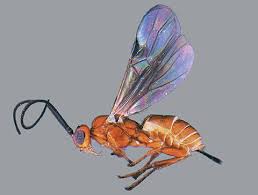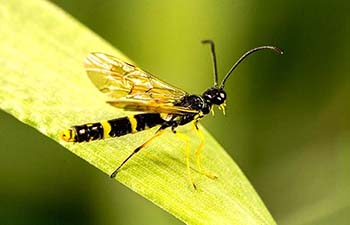This is a Way-Back Wednesday post featuring an article from the 2005 Farming Smarter Magazine edition.
You can't get away from the sawfly, but you can keep the damage they do to a minimum. Alberta Agriculture entomologist, Scott Meers, has been reviewing all the information he can find on sawflies to complete his master's degree studies. He's found what works and what doesn't.
Contact insecticides have very little impact on the sawfly population as a whole because the sawfly spends 50 weeks of 52 inside a grass or cereal stem. Not all the adults enjoy their brief time in the sun at the same time, so spraying misses most of them and beneficial insects likely suffer greater harm.
"I've seen fields where the edges were sprayed against 'hoppers four times in early summer when sawfly were active," says Meers. "About 50 percent of the stems were cut, so sawfly avoided serious losses."
Fortunately, sawfly aren't entirely safe inside a wheat stem. A sawfly lays only one egg in each stem, but other females lay eggs in stems that already have eggs. The larvae cannibalize one another.

Larvae of Bracon cephi, a parasitoid (a parasitic insect that kills its host) of sawfly, also consume sawfly larvae inside stems. The parasitoid finds sawfly larvae by the vibration of their feeding. It lays an egg through the wheat stem onto the larva and the emerging parasitoid larvae consumes the sawfly.
Tillage isn't an effective way to control sawfly either. After it's notched the base of the wheat stalk, the larva spins itself a silken cocoon that acts as a moisture barrier.
"In a hot dry spring, you can dry out some sawfly with tillage," says Mears. "But, overall, sawfly damage seems to be worse with tillage. Sawfly can climb out from under the soil, but Bracon cephi, doesn't survive burial very well."
Swathing high helps parasitoids winter successfully. Like sawfly, Bracon cephi overwinter in the straw, but slightly higher in the stem. Parasitoid survival is best in stripper-headed straw or stubble straight-cut just below the heads, but most survive in eight-inch stubble.
The traditional advice to seed later or to seed worst infested fields last does reduce sawfly damage. But, late seeding in this context means early June. The treatment causes more losses than the pest.
Winter wheat usually suffers less sawfly damage than spring wheat because sawfly lays her eggs into stems that are elongating. Winter wheat develops beyond this stage by the time most sawfly emerge and mate, so only a few stalks are affected. In Montana, where winter wheat is the main cereal, an early emerging population of sawfly has evolved to attack winter wheat.
In Alberta, it seems the sawfly has adapted to early seeding as normal seeding dates have moved up. Its parasitoid hasn't adapted as quickly.
Wheat varieties with stronger straw are effective in reducing the number of stems cut. Meers prefers to call the sawfly resistant varieties, Leader, Lancer and AC Eatonia, strong-strawed rather than solid stemmed. They don't break over as easily as other varieties, but the solidness of the stems depends on summer weather. The stems only fill with pith in a summer with abundant sunshine.

"Sawfly can tunnel through solid stems, but they don't go as far, especially not when they're small," says Meers. "As a result, they don't develop as well as larvae in hollow-stemmed wheat. When they emerge next summer, those sawfly lay fewer eggs that weigh less.
"You'll probably see some cutting with a solid-stem wheat. If 70 to 90 percent of hollow-stem wheat stalks were cut, 20 or 30 percent of solid-stems will be cut. Most sawfly resistant wheats have slightly lower yield potential, but, under heavy sawfly attack, they yield is about the same as other wheats."
Swathing doesn't protect against sawfly damage, it's a rescue treatment, says Meers. As sawfly larvae are tunneling in the wheat stalks, they're cutting into yields by reducing transfer of nutrients to the seed heads.
Estimates of yield loss range from zero to 35 percent. Meers believes losses are at least 20 percent because sawfly prefer to lay their eggs into the biggest stems available ≥ the main stems rather than tillers and these are the source of most of the yield. Some studies show a drop in grain protein, others show sawfly have no impact.
Rotation into a broadleaf crop prevents attack in that field. But, it doesn't protect nearby cereal crops. Although they're generally described as poor fliers, sawfly can travel at least a mile in search of host plants.
"Watch your neighbor's rotations as well as your own," Meers advises. "If you want to protect a particular crop, use a trap strip. Trap crops can be a logistical nightmare, but they can be effective.
"Oats are the only cereal that isn't affected by sawfly feeding. The insects lay eggs in oats, but the larvae don't survive.
"A barrier of oats between a field that was heavily infested last year and a broadleaf crop can hold the sawfly and prevent them from crossing the broadleaf to attack wheat on the far side." Sawflies are attracted by the chemicals from cereals and some varieties of wheat are more attractive than others. Wheat is apparently more attractive than barley, sawfly cross barley trap crops to lay eggs in wheat.
